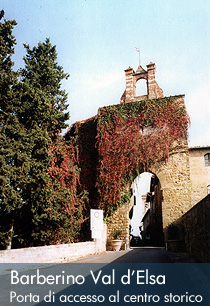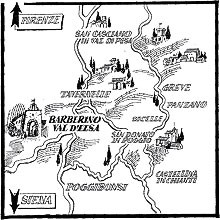
Barberino di Val d’Elsa is a charming ancient village.
The Palazzetto Pandolfini Covoni in Barberino di Val d’Elsa and the farm were inherited by Caterina, daughter of Giuseppe Borghese and Maria née Covoni Pandolfini, Dukes of Poggio Nativo. Maria had been the heiress of the family of Covoni Pandolfini property (land, woods and part of the village of Barberino) in the family since the 14th century. The Pandolfini’s stone coat of arms with three little dolphins is over the front door of the house.
Barberino is in the center of Tuscany, it’s origin is Etruscan. The Pasolini Borghese historical buildings probably were built on Roman foundations. In the Middle Ages they sheltered refugees from the frequent battles between Florence, Siena and the little town of Semifonte, which was destroyed. The Palazzetto Pandolfini Covoni was fortified, so as to resist the assault from Siena.
The view from Barberino is deeply Tuscan: the valley is a harmonious sequence of ancient Tuscan farms, hill after hill, covered with olive trees, vineyards and woods. Close-by the Palazzetto Pandolfini there is a little wood called ragnaia, it is the last bit of a grand ragnaia, quoted by historians as one of the biggest in Tuscany.
One of the special features of rural architecture in Tuscany is the piccionaia: a short tower on the roof. In ancient times during famine or wars the peasants, unable to hunt, used the piccionaia to keep pigeons, the only available food supply.
The present Pasolini dall’Onda family inherited the property from their mother, Caterina Pasolini Borghese.


